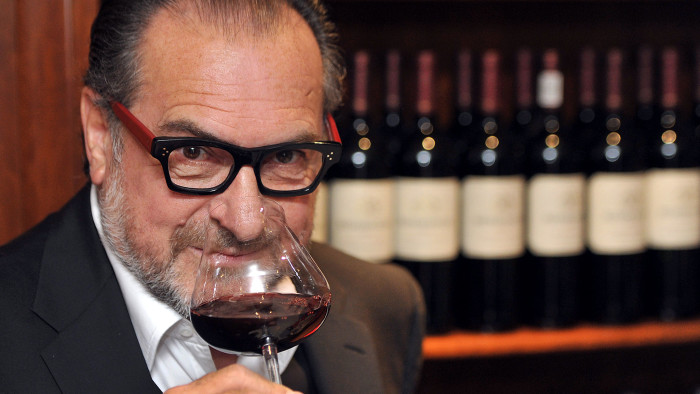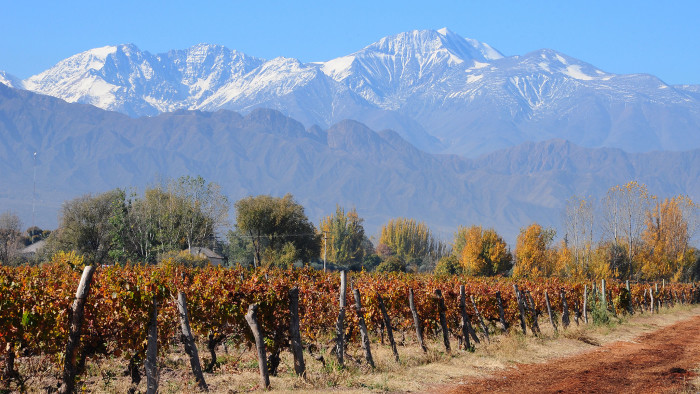How a Frenchman helped transform Argentina’s wine industry

Roula Khalaf, Editor of the FT, selects her favourite stories in this weekly newsletter.
The French winemaker and consultant Michel Rolland takes a long, deep sniff from a glass of Mariflor Camille 2009. With a deftness that betrays decades of practice, he takes a swig, gurgles and spits it into a jug. “It has everything, but a bit more,” he announces.
Dressed entirely in black, Rolland sits back to absorb the flavours of the inky Malbec wine with an air of satisfaction. “Nothing is harsh or disturbing to the mouth. It takes on another dimension,” he says, “a blend between power and finesse.”
That the renowned oenologist so approves of this particular Argentine wine is not entirely surprising — he made it himself. Modesty may not be Rolland’s forte, but as one of the most influential figures in the world of wine he has probably earned the right to brag.
In Argentina in particular, the 68-year-old Bordeaux-based winemaker is credited with revolutionising an industry once content to turn out mainly table wines. He helped to introduce techniques — such as pruning vines and limiting irrigation — that have ushered in a new era for Argentine wine over the past two decades. Some of its now trademark Malbecs are among the best in the world.
So it is with some trepidation that, as someone who delights in a nice glass of wine but is no expert, I try Rolland’s Mariflor Camille 2009. We are sitting in his Buenos Aires waterside apartment and he is peering intensely at me as I sip.
“Do you like it?” he asks. I certainly do. “That’s the most important thing. Forget about the adjectives,” he says, displaying a healthy disregard for the extravagant vocabulary often employed to describe wine.
Rolland first came to Argentina in 1988, when Arnaldo Etchart, an ambitious winemaker in the northern province of Salta, enlisted his help to break into a hitherto unimpressed US market. Etchart’s subsequent success, thanks to the Frenchman’s talent for turning around a wine’s fortunes, meant Rolland became the most sought-after wine consultant in Argentina. His many clients in the country have included the Trapiche, Norton, Salentein and Benegas Lynch wineries.

Some might argue too many: the man who travels so extensively around the world’s vineyards that his nickname is the Flying Frenchman is not without critics. He has many supporters and many satisfied clients, and his influence on the industry is undeniable. But some fellow professionals accuse him of dumbing down viniculture, of pandering to mass-market tastes. A 2004 film, Mondovino, aired much of that controversy.
Argentina has been making and drinking wine for nearly five centuries, starting with the country’s first vineyards cultivated by Spanish colonisers in the mid-16th century. Thanks to large numbers of later European immigrants, by the 1970s Buenos Aires was third only to Paris and Rome in wine-consuming capitals. Yet despite the demand, Argentina produced mainly average wines.
In 1999 Rolland started planting his own vines in what is now Clos de los Siete, an exclusive group of seven high-altitude vineyards in Mendoza province in a magnificent setting at the foot of the Andes. That was when he became truly invested in Argentina. “We wanted to show that Argentina was a country with great potential. It wasn’t so obvious then, even if it is obvious today,” he says.
Indeed, it wasn’t so long ago that in his native France, wine professionals were dismissive of Argentina. Many were barely even aware that the country made wine at all. “French people used to ask, ‘They make wine there?’ They’re not asking that question any more,” he says. Indeed, the Malbec grape, originally from France, is today largely identified with Argentina.

Malbec is certainly the most consistent grape in Argentina, prospering even in the bad years in a uniquely extensive wine region that runs along the foothills of the Andes for some 2,000km from close to Argentina’s border with Bolivia in the north to Patagonia in the south. But Rolland predicts that Cabernet Franc will also have “a very good story” in Argentina. “Malbec is always quite strong and powerful, while Cabernet Franc is the best example of elegance and finesse, so the mix is doing very well,” he says. “I would like to plant more.”
There are challenges to wine cultivation in the Andean foothills, such as hailstorms, which one year tore down from the mountains to wipe out an entire harvest at Clos de los Siete. But Rolland is optimistic about the prospects for Argentine wine, especially after the recent change in government that he says has greatly improved business conditions: “Politics is much more dangerous than hail. But it’s getting better now.”
Even so, Rolland acknowledges that superior Argentine wine is a very young industry. The best wines only emerged from about 2000 onwards. “Good wine and great wine are not the same thing. You can only know if it’s a great wine 20 years after making it, so we don’t know yet in Argentina,” he says.
That is one reason why Rolland has named the wine we are drinking after one of his grandchildren, Camille. “When you are a grandfather you do everything you can for your grandchildren,” he says. “In 20 years I may not be around but my grandchildren will be.”
Comments